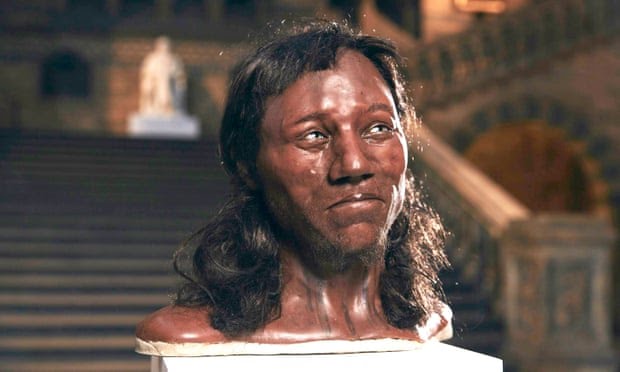I grew up being told that a prerequisite for our national identity was white skin – that prejudice has been proved false
By Aarathi Prasad
The results of 10,000-year old Cheddar Man’s DNA analysis have hit the headlines in 2018, accompanied by a striking portrait that needed no words. Here was this bona fide European – indeed, an ancestral Brit – and the man was black. Genetic analysis suggests he had blue eyes, and that his skin was probably darker, even, than the portrait shows. Three hundred generations later, allowing for a little variation between individuals, about 10% of the genome of many white British people alive today comes from this man’s dark-skinned population.
Contrary to some comments made on the story, Cheddar Man was no anomaly – no lost, tanned tourist to the British Isles. Rather, he was of a group known as the western hunter-gatherers, who migrated into Europe at the end of the last ice age, like other ancestral Europeans found in Spain, Hungary and Luxembourg. As with our British ancestor from Cheddar, their DNA has also been analysed, and the results show that these Europeans, too, had the same dark skin.
Back in 1998, when the first Cheddar Man reconstruction was revealed, it portrayed a light-skinned, brown-eyed ancestor, with straight, brown hair. That model was created without the benefit of genetic data, which is why assumptions about his colouring were made. We know all humans ultimately came from Africa, so nobody’s original ancestors were white. But those who came to Europe, certainly by the period in question, were thought to be Europe-adapted; including having a skin colour appropriate to local levels of ultra-violet radiation. Without going into the complexities, having the “wrong” skin colour could land you with vitamin D3 deficiency, poor reproductive success or UV-induced injury.
Technically, for Europe, white should have meant right – though the darker coloration of some northern populations, such as Arctic indigenous peoples, worked fine. This is probably because marine mammals, fish and caribou were major components of their traditional diets, providing vitamin D3 in abundance. Cheddar Man would likely have had a D3-rich diet, too. But without this kind of detailed information, his 1998 portrait could only be based on the known looks of migrants who came to the British Isles from the Near East some 4,000 years after his people, and on the recorded depigmentation of the skin that evolved independently in ancestors of modern Europeans. All of this resulted in a Europe about 6,000 years ago whose population mainly showed variants of light skin tones. These were the beginnings of the white European.
Though it is at least as old as humanity, migration seems to be something that humanity has never really managed to make peace with. In 2017, YouGov research asking who Brits consider to be “British” highlighted the limits to which even citizenship can confer “Britishness”. Their data showed only 49% of those polled considered someone originally from another country who gained British citizenship to be “British”.
Arguably it’s one of the results of migration – the juxtaposition of visible difference – which provides the space in which friction occurs. For example, all of my great-great-grandparents were British “subjects”, compared with one side of Nigel Farage’s family, who reportedly were more recent German migrants. But I am dark brown, and he is not. This means that I am regularly asked where I am from, while he is probably not. It means I was called “Paki” in the 70s, 80s, 90s and after the Brexit referendum vote. It was the reason why other brown children at my secondary school clarified to each other that we could not call ourselves English, though we were born here. It identified us as “other”. The societal and historical message we intercepted and deciphered as children was that white skin was the prerequisite for our national identity.
Like eye colour, the genetics of skin pigmentation is complex – there are something like 80 genetic variants spread over 18 chromosomes. Our evolutionary origins are in Africa, whose enormous genetic diversity results in a range of possible skin and eye colours among Africans. Brazilians have multiple terms to describe the skin colour diversity of their population; a similar scenario exists in India. Such observation of difference is clearly not always neutral; pernicious “chromatocracies” fester in many societies, predominantly based on a hierarchy in which light skin tones are superior. Be that as it may, explorations of genetic and societal diversity serve to emphasise that skin colour has never been a sound proxy for “race”, nor for nationality.
In and of itself, the new Cheddar Man is a compelling sculpture of an ancestor thanks to artists Alfons and Adrie Kennis, who modelled a face from deep history that is unusual in its expression of an intelligence, sentiment and sensibility, and which is based on scientific information rather than imagination and assumptions of racial type. But for me – dark, British and too often identified as other – he is particularly resonant. Knowing that skin colour diversity runs so deep in British DNA somehow makes me feel more comfortable in my skin, too.
• Dr Aarathi Prasad is a biologist and author based at the Division of Biosciences, University College London
•Opinions, positions or thoughts expressed here are personal and strictly of the writer/author and not The Daily Crucible.









































